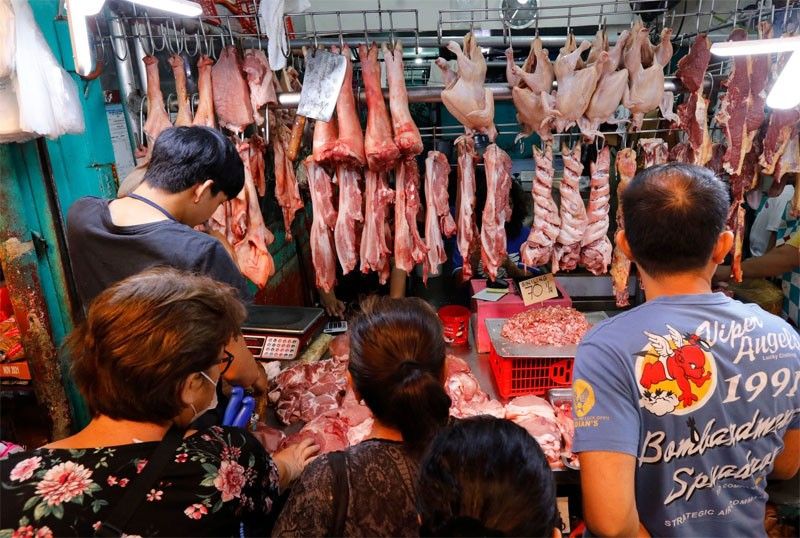DA exec warns of possible pork shortage by April

MANILA, Philippines — A shortage in the supply of pork could be felt starting next month amid the outbreak of African swine fever (ASF) in the country, an official of the Department of Agriculture (DA) said yesterday.
At a press conference, Agriculture Assistant Secretary and deputy spokesman Rex Estoperez confirmed the earlier warning of the National Livestock Program (NLP) that there would be a shortage of at least 46,104 metric tons in the pork supply this June, compared to the demand of 145,849 MT.
“That’s the projection. We still need to verify if the projection is correct, but it may be too late,” Estoperez said, referring to the shortage starting April.
Based on the presentation of NLP director Ruth Miclat-Sonaco during a recent consultation of the DA with various stakeholders, the country will start to experience the local pork shortage next month, with possible deficiency of at least 11 days or shortfall of at least 56,180 MT.
Sonaco said that by June, the country could have at least 39 days of shortage in the pork supply.
Estoperez warned that the ASF would continue to spread if local government units (LGUs) and the public will not cooperate to contain the virus.
“As long as we do not cooperate, as long as we do not follow protocols, that will happen, that is why we are appealing to our fellow Filipinos to cooperate. Right now, we are doing our best to coordinate with LGUs to avoid the spread,” he said.
The DA official made the warning after Cebu Gov. Gwen Garcia stopped the culling operation in areas in the province affected by the ASF.
“It will not only affect the swine industry, but it will also affect the consumers because prices will go up if we will not cooperate,” Estoperez said.
He added that the DA data are now being harmonized with the inventory from stakeholders.
The agriculture deputy spokesman also reacted to the warning of farmers’ group Philippine Chamber of Agriculture and Food Inc. (PCAFI) president Danilo Fausto that the retail price of pork could further increase after reaching as high as P420 per kilo in Metro Manila markets amid the looming shortage brought by the ASF.
“We don’t want to speculate on the prices, as it is the function of demand and supply, as it could be adopted by retailers,” Estoperez said.
Based on the monitoring of the DA, the retail price of pork liempo ranged from P340 to P420 per kilo and kasim from P270 to P350 per kilo.
“The shortage will spike the prices. As a matter of fact, my estimate is like what happened to the prices of onions,” Fausto said in an earlier interview with The STAR.
Estoperez said the government is studying proposals from hog raisers to provide compensation to encourage them to report ASF cases.
“That’s the proposal, but we are still studying whether the DA has the capability,” he added.
For Pork Producers Federation of the Philippines Inc. (PROPORK) chairman and AGAP party-list Rep. Nicanor Briones, the government should allocate a budget for 10 percent of the entire livestock population and provide at least P10,000 compensation for hog raisers.
“The ASF was never controlled. Nobody is saying that their pigs have ASF because of lack of compensation,” Briones said.
He added that the DA has proposed a plan to control the spread of the disease, but did not implement it due to lack of funding.
He noted that hog raisers in Luzon have already lost P100 billion as the ASF continues to spread in the country.
Based on data from the Bureau of Animal Industry (BAI), at least 15 regions had been affected by the ASF as of March 5: the Cordillera Administrative Region, Ilocos, Cagayan Valley, Central Luzon, Calabarzon (Cavite, Laguna, Batangas, Rizal, Quezon), Mimaropa (Mindoro provinces, Marinduque, Romblon, Palawan), Bicol, Western Visayas, Central Visayas, Eastern Visayas, Zamboanga peninsula, Northern Mindanao, Davao, Soccsksargen (South Cotabato, Cotabato, Sultan Kudarat, Saranagani, General Santos) and Caraga.
Only the Bangsamoro Autonomous Region in Muslim Mindanao is ASF-free.
Re-evaluation
The country’s P260-billion swine industry is at great risk if the existing protocol of the BAI against the ASF is not re-evaluated, according to PROPORK.
In a statement, PROPORK president Rolando Tambago urged the BAI to seriously look into what the Cebu provincial government is doing now to mitigate the impact of ASF on the industry.
Tambago said the country has already lost half, or at least five million heads of its swine population due to the ASF; however, this was not purely because of actual infections, but because of the implemented protocols.
“The BAI’s existing protocol of culling even healthy pigs within a 500-meter radius, which caused farmers to panic, contributed to this loss of the hog inventory,” he added.
The PROPORK official observed that the industry thinks the method of culling is counterproductive to food security and causes the disease to spread even more as farmers who fear total loss will be encouraged to sell their hogs, or even smuggle out sick ones.
“They’ve been doing this protocol for more than three years, yet the disease continues to spread,” Tambago said.
PROPORK warned of a possible massive supply shortage of pork, causing spikes in retail prices within two to three months if indiscriminate culling of healthy pigs continues.
“We laud the move of Gov. Gwen Garcia of Cebu to seek alternative approach to avoid seeing the industry shrinking more,” Tambago said.
Based on the declaration of the DA-Region 7’s current executive director, Central Visayas is the only remaining biggest pig-producing region left, and this move by the Cebu provincial government gives hope for the industry.
The protocol adopted by Cebu places emphasis on culling only the sick hogs and saving healthy ones.
Massive testing for swine fever (ASF & CSF) is now being initiated throughout the province down to the purok level, employing more than 10,000 workers.
Healthy hogs are subjected to multi-level veterinary guidelines before slaughter.
For PROPORK, this action of Cebu province takes a lot of courage, strong leadership and faith to fight the deadly swine disease and at the same time, protect the remaining inventory.
Should the BAI still continue to implement the current protocol without seriously considering and evaluating Cebu’s move, Tambago said the industry would surmise that this is intentionally done to make way for more importation.
“In 2022, the country imported 710.3 million kilograms of pork at a reduced tariff. That’s almost half of the country’s annual demand. If we fail to protect the remaining half of our local industry, there is a high possibility that we will be fully reliant on imported pork, and consumers will eventually suffer due to lack of food security,” he added.
Last year, pork imports grew 28.06 percent to 710.36 million kilos from the 554.7 million kilos shipped in the previous year. It accounted for more than half of total meat imports, BAI data showed.
In the first two months of this year, pork was the top major imported meat, accounting for 41.89 percent of the total.
The latest BAI data showed pork imports reached 69.59 million kilos, lower by 14.41 percent from 81.3 million kilos shipped in the same month last year. – Danessa Rivera
- Latest
- Trending
































